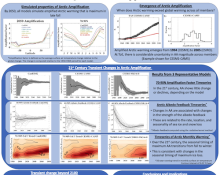The Emergence and Transient Nature of Arctic Amplification in Coupled Climate Model Large Ensembles
Marika
Holland
National Center for Atmospheric Research
Poster
Under rising atmospheric greenhouse gas concentrations, the Arctic exhibits amplified warming relative to the globe. This Arctic amplification (AA) is a defining feature of global warming. However, the Arctic is also home to large internal variability, which can make the detection of a forced climate response difficult and the magnitude of AA uncertain. Here we use results from seven model large ensembles, which have different rates of Arctic warming and sea ice loss, to explore the seasonality of AA and uncertainty in AA magnitude. We assess the time of emergence of anthropogenically-forced Arctic amplification, finding that all models exhibit emergence near the turn of the century. In an analysis of transient changes in this amplified signal for the 21st century and beyond, we find that that the maximum Arctic warming transitions from fall to winter due to sea ice reductions that extend further into the fall. Additionally, the magnitude of AA declines over the 21st century associated in part with a weakening albedo feedback strength. In a simulation that extends to the 23rd century with a high emission scenario, we find that the transient magnitude of AA is related to the seasonality of ice loss and consequent impacts on absorbed solar radiation. As sea ice cover is lost throughout the year in the latter part of the 22nd century, there is little further reduction in the surface albedo and Arctic amplification saturates at a level that is reduced from its 21st century value.

holland-marika-polar-poster.pdf
(3.71 MB)
